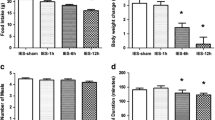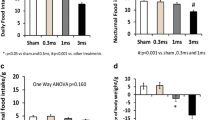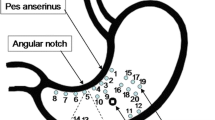Summary
This study tested the effects of the gastrointestinal pulse train electrical stimulation with different parameters and at different locations on the neuronal activities of the lateral hypothalamus area (LHA) in obese rats in order to find the optimal stimulation parameter and location. Eight gastric electrical stimulations (GES) with different parameters were performed and the neuronal activities of gastric-distension responsive (GD-R) neurons in LHA were observed. The effects of stimulations with 8 parameters were compared to find the optimal parameter. Then the optimal parameter was used to perform electrical stimulation at duodenum and ileum, and the effects of the duodenal and ileac stimulation on the GD-R neurons in LHA were compared with the gastric stimulation of optimal parameter. The results showed that GES with the lowest energy parameter (0.3 ms, 3 mA, 20 Hz, 2 s on, 3 s off) activated the least neurons. The effects of GES with other parameters whose pulse width was 0.3 ms were not significantly different from those of the lowest energy parameter. Most gastric stimulations whose pulse width was 3 ms activated more LHA neurons than the smallest energy parameter stimulation, and the effects of those 3 ms gastric stimulations were similar. Accordingly, the lowest energy parameter was recognized as the optimal parameter. The effects of stimulations with the optimal parameter at stomach, duodenum and ileum on the LHA neuronal activities were not different. Collectively, gastrointestinal electrical stimulation (GIES) with relatively large pulse width might have stronger effects to the neuronal activities of GD-R neurons in LHA of obese rats. The effects of the GIES at different locations (stomach, duodenum and ileum) on those neurons are similar, and GES is preferential because of its easy clinical performance and safety.
Similar content being viewed by others
References
WHO. Global Database on Body Mass Index. (Accessed January 10, 2012 at http://apps.who.int/bmi/index.jsp)
Pelleymounter MA, Cullen MJ, Wellman CL. Characteristics of BDNF-induced weight loss. Exp Neurol, 1995, 131(2):229–238
Ruffin M, Nicolaidis S. Electrical stimulation of the ventromedial hypothalamus enhances both fat utilization and metabolic rate that precede and parallel the inhibition of feeding behavior. Brain Res, 1999,846(1):23–29
Qu D, Ludwig DS, Gammeltoft S, et al. A role for melanin-concentrating hormone in the central regulation of feeding behavior. Nature, 1996,380(6571):243–247
Sakurai T, Amemiya A, Ishii M, et al. Orexins and orexin receptors: a family of hypothalamic neuropeptides and G protein-coupled receptors that regulate feeding behavior. Cell, 1998,92(4):573–585
Simpson KA, Martin NM, Bloom SR. Hypothalamic regulation of food intake and clinical therapeutic applications. Arq Bras Endocrinol Metabol, 2009,53(2):120–128
Morton GJ, Cummings DE, Baskin DG, et al. Central nervous system control of food intake and body weight. Nature, 2006,43(7109):289–295
Sun Y, Chen J. Intestinal electric stimulation decreases fat absorption in rats: therapeutic potential for obesity. Obes Res, 2004,12(8):1235–1242
Yin J, Ouyang H, Chen JD. Potential of intestinal electrical stimulation for obesity: a preliminary canine study. Obesity (Silver Spring), 2007,15(5):1133–1138
Cigaina V. Gastric pacing as therapy for morbid obesity: preliminary results. Obes Surg, 2002,12(Suppl 1):12S–16S
Yin J, Chen JD. Mechanisms and potential applications of intestinal electrical stimulation. Dig Dis Sci, 2010,55(5):1208–1220
Xu J, McNearney TA, Chen JD. Gastric/intestinal electrical stimulation modulates appetite regulatory peptide hormones in the stomach and duodenum in rats. Obes Surg, 2007,17(3):406–413
Tang M, Zhang J, Chen JD. Central mechanisms of gastric electrical stimulation involving neurons in the paraventricular nucleus of the hypothalamus in rats. Obes Surg, 2006,16(3):344–352
Zhang J, Zhu H, Chen JD. Central neuronal mechanisms of intestinal electrical stimulation: effects on duodenum distention-responsive (DD-R) neurons in the VMH of rats. Neurosci Lett, 2009,457(1):27–31
Zhang J, Maude-Griffin R, Zhu H, et al. Gastric electrical stimulation parameter dependently alters ventral medial hypothalamic activity and feeding in obese rats. Am J Physiol, 2011,301(5):G912–918
Qin C, Sun Y, Chen JD, et al. Gastric electrical stimulation modulates neuronal activity in nucleus tractus solitarii in rats. Auton Neurosci, 2005,119(1):1–8
Sun Y, Qin C, Foreman RD, et al. Intestinal electric stimulation modulates neuronal activity in the nucleus of the solitary tract in rats. Neurosci Lett, 2005,385(1):64–69
Qin C, Chen JD, Zhang J, et al. Modulatory effects and afferent pathways of gastric electrical stimulation on rat thoracic spinal neurons receiving input from the stomach. Neurosci Res, 2007,57(1):29–39
Garcia Diaz E, Martin Folgueras T. Systematic review of the clinical efficacy of sibutramine and orlistat in weigth loss, quality of life and its adverse effects in obese adolescents. Nutr Hosp, 2011,26(3):451–457
Schroeder R, Garrison JM Jr, Johnson MS. Treatment of adult obesity with bariatric surgery. Am Fam Physician, 2011,84(7):805–814
Xu X, Lei Y, Chen JD. Duodenum electrical stimulation delays gastric emptying, reduces food intake and accelerates small bowel transit in pigs. Obesity (Silver Spring), 2011,19(2):442–448
Xu X, Lei Y, Chen JD. Effects and mechanisms of electrical stimulation of the stomach, duodenum, ileum, and colon on gastric tone in dogs. Dig Dis Sci, 2010,55(4):895–901
Zhang J, Liu S, Tang M, et al. Optimal locations and parameters of gastric electrical stimulation in altering ghrelin and oxytocin in the hypothalamus of rats. Neurosci Res, 2008,62(4):262–269
Tang M, Zhang J, Xu L, et al. Implantable gastric stimulation alters expression of oxytocin and orexin-containing neurons in the hypothalamus of rats. Obes Surg, 2006,16(6):762–769
Author information
Authors and Affiliations
Corresponding author
Additional information
The authors contributed equally to this work.
This project was financially supported by National Natural Science Foundation of China (No. 30870927).
Rights and permissions
About this article
Cite this article
Yan, Y., Xiang, Xl., Qian, W. et al. Changes of neuronal activities after gut electrical stimulation with different parameters and locations in lateral hypothalamus area of obese rats. J. Huazhong Univ. Sci. Technol. [Med. Sci.] 34, 510–515 (2014). https://doi.org/10.1007/s11596-014-1307-z
Received:
Revised:
Published:
Issue Date:
DOI: https://doi.org/10.1007/s11596-014-1307-z




